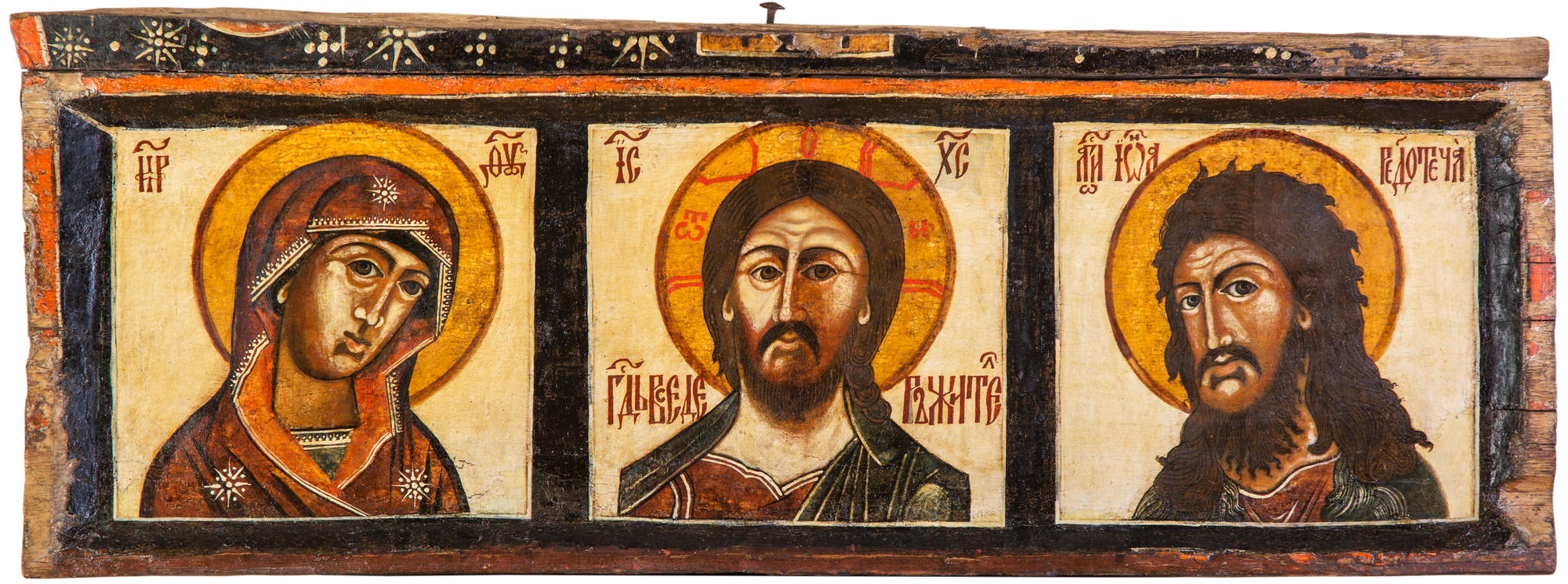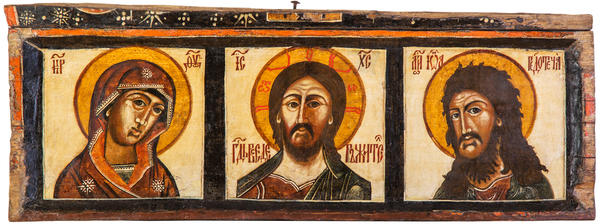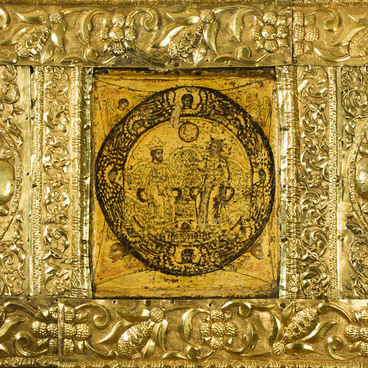This deesis was made in the first quarter of the 18th century by an unknown master. The word ‘deesis’ translates from the Greek language as ‘supplication’, ‘plea’. Before exhibition in the museum the icon was set in the Pokrovsky Church of the Spassky monastery in Murom. That church was built in 1691 with the funds of Varsonofiy, the Metropolitan of Sarsk and Podonsk. He belonged to the Chertkovys – a landowner family who lived in the suburbs of Murom.
The icon was set above the door at the Pokrovsky Church.
The deesis consists of a solid horizontal board and a roof-shaped cover that is attached to the board with forged nails. The icon has several particular features. Its composition is divided into 3 equal parts and there is no common background for the images despite they are painted at one board. Each image has its own wide frame and looks independently as if it would be painted at a separate board.
The composition of 3 parts is the most wide-spread type of the ‘small deesis’. Such icons were used to decorate altar barriers that originated from Byzantium and then transformed into multifigural iconostases in Russia. In the late Middle Ages, they were often set at the porch above the entrance of a church, a Royal Chamber or a monastery refectory, and that is confirmed by the story of this deesis.
The three-part composition depicting Jesus Christ, the Mother of God and John the Baptist can be referred to the simplest pattern that is called a ‘trimorph’ in Greek (which means that it consists of 3 images).
At the icon only the heads and shoulders of the saints are depicted, that’s why such deesis is called “oplechnyi” or “shoulder-length”. The painting style of all the saints’ faces is unified: they have extended faces and tough features. The clothes are painted schematically without any details for the fold shapes.
Such style of icon painting in the second half of the 17th century was quite wide-spread, it can be explained by a renewed interest to the ancient art objects and the Greek traditions.
The iconographic style of the Murom icon is relevant to many shoulder-length icons of the edge of the 17-18 centuries. Such icons were painted by the masters of the Armory Chamber and then distributed all over the country.
The deesis consists of a solid horizontal board and a roof-shaped cover that is attached to the board with forged nails. The icon has several particular features. Its composition is divided into 3 equal parts and there is no common background for the images despite they are painted at one board. Each image has its own wide frame and looks independently as if it would be painted at a separate board.
The composition of 3 parts is the most wide-spread type of the ‘small deesis’. Such icons were used to decorate altar barriers that originated from Byzantium and then transformed into multifigural iconostases in Russia. In the late Middle Ages, they were often set at the porch above the entrance of a church, a Royal Chamber or a monastery refectory, and that is confirmed by the story of this deesis.
The three-part composition depicting Jesus Christ, the Mother of God and John the Baptist can be referred to the simplest pattern that is called a ‘trimorph’ in Greek (which means that it consists of 3 images).
At the icon only the heads and shoulders of the saints are depicted, that’s why such deesis is called “oplechnyi” or “shoulder-length”. The painting style of all the saints’ faces is unified: they have extended faces and tough features. The clothes are painted schematically without any details for the fold shapes.
Such style of icon painting in the second half of the 17th century was quite wide-spread, it can be explained by a renewed interest to the ancient art objects and the Greek traditions.
The iconographic style of the Murom icon is relevant to many shoulder-length icons of the edge of the 17-18 centuries. Such icons were painted by the masters of the Armory Chamber and then distributed all over the country.




